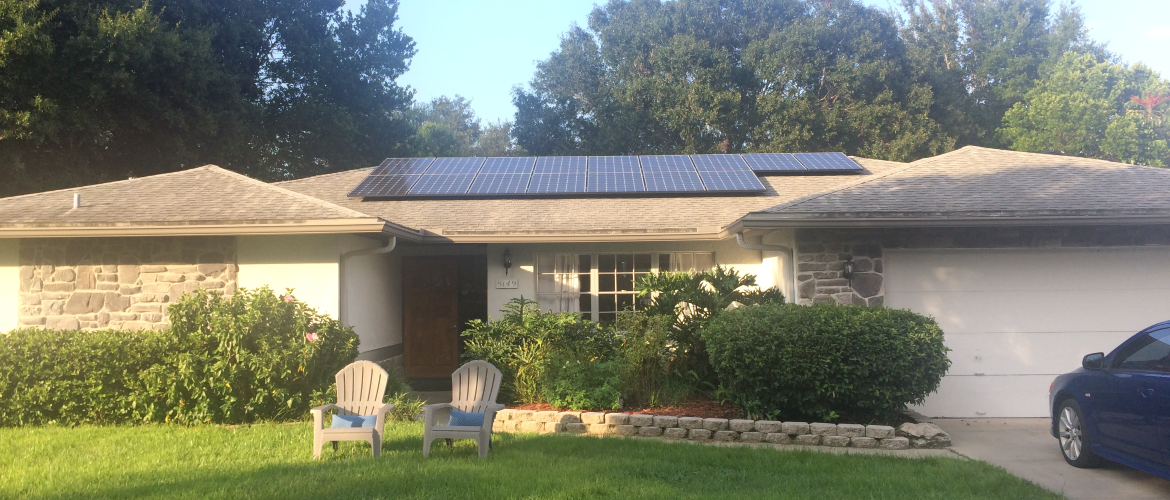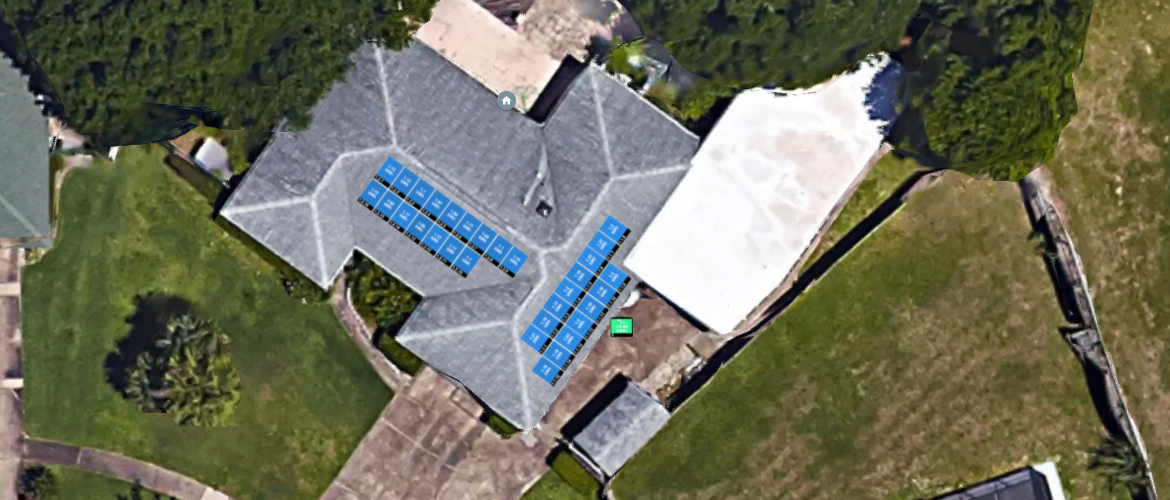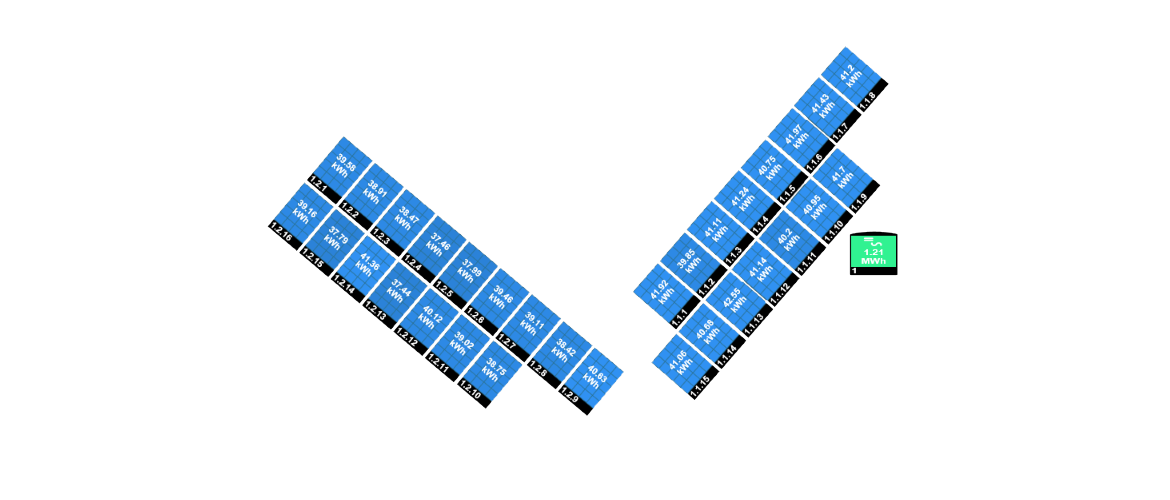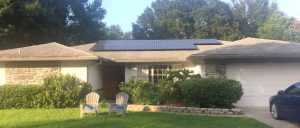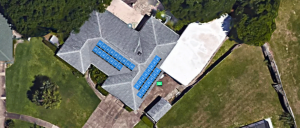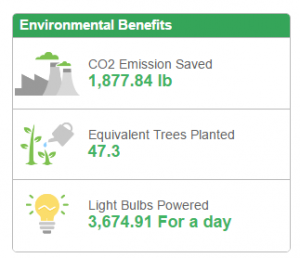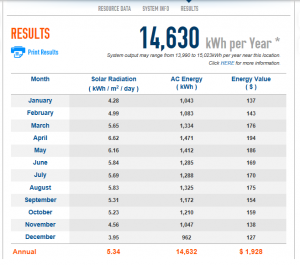After spending some time looking at Solar PV, I have found between the Federal Tax Credits, and financing options that you can produce your own electricity for less than you are paying the electric company. While I started this process not knowing if it was cost effective to move to solar, I found out that even if you do not have the upfront cash, it is cheaper to go solar today than stay with electric company.
You may wonder why I am publishing this on my Game Development site. Well, I feel reducing our carbon footprint is very important. It also is easier (and cheaper) to add content here than start a completely separate site. Lastly, both might add traffic to the other. Thanks for understanding.
Background
I looked into solar energy for some time prior to going to choosing a company and a system. Since then, the questions keep coming-
Is Solar really cheaper?
Does a Solar PV system cost a lot?
Why did you take out a loan? Where did you get one?
I figured that I would post my research so I can remember all the little details that I discovered. Hopefully, others will find this research useful.
Spoiler
I am an engineer by degree, so there is a lot of math on this site. If you want the short answer, taking out a solar loan at up to 6% for 20 years still has a higher ROI than paying for electricity provided by a energy company. There are other ways to save as well, like improve your insulation, upgrade your HVAC. But with solar, you can reduce your monthly electric bill with little to no up-front costs.
Who did I have install my solar PV system?
After interviewing a number of solar companies in the Orlando area, I eventually decided to go with Everything Solar. And while I cannot say enough good things about Brad Launs & his team, I promise the site will be generic.
My House
I live in Dr. Phillips, which is an unincorporated suburb of Orlando in Orange County, Florida. My house is a 1986 block and wood construction. I bought the house in February of 2016, so I have not had much time to do significant improvements. As such, much of the house is original 80’s construction. I have single pane windows and an approximate R15 in my attic. I have 1950 sq ft in the main house and an additional 750sq ft in an attached in-law suite.
My PV Solar Array and House
The Logical Array
The Bird’s Eye View
I just replaced the AC system of the main house (2016) with a 3.5 ton, 16 seer, 8.2 HSPF system. The big white area in the picture above is an in-law suite with a separate 2-ton system that is of unknown age or SEER. We keep the in-law suite cooled to 82F to keep the mold away and the electric bills low.
I have two hot water heaters, but I keep the one in the in-law off, unless we have guests. Since I have not been in the house for more than one year, I do not have a good idea of overall kW usage per month. I do have two good base months.
April 900kW – without any AC running
July 2500 kW – Full AC running
My wife and I both work from home so we do not get the typical energy saving of being away during the day. This means to reach Net Zero, I have to work harder than most.
My PV Solar System
My system specifically is an 8.37kW Solar PV Solar Edge system installed in August 2016. I have individual power optimizers on each of my 31 panels that feed into one large inverter. If you want to see the performance of my system, Solar Edge provides a real-time website of my system. I took a screenshot just after the first month’s production. Look at how much impact we already had on the environment after generating 12,100kWh of electricity.
That is like planning 1.5 trees a day simply by having the PV Solar array sit on your roof.
An acre of land, if you are planting Christmas trees, has about 1100 trees/acre. This means I generate one new forest every two years. Over the 20yr loan, I will have generated almost 11,000 trees or 10 acres of forest.
Said differently, I live on almost 1/2 an acre. This is like planting 550 trees on my property each year.
Other Relevant Details
In my area, if you go over 10kW, then there is an additional cost imposed by the power company, so I plan on reducing my electric consumption until I have a maximum of 10kW consumption.
My power company also buys electricity at a very discount rate in comparison to what I purchase it for. This means it is more cost-effective for me to get close to Net Zero as possible without going over. Since I did not want to go over, I started with an 8.37kW system. This gives me room to add 5 more panels if I need them later. I also went with a hybrid hot water heater but left room on the roof for Solar hot water.
Lastly, I did not get a Solar Attic Fan. I am not saying I won’t eventually, but for now, the money here I felt was better spent sealing my attic vents and upgrading the R-Value by adding blow-in insulation.
Solar PV Calculations
Calculating the Size of the PV Solar Array Needed for Your Home
The basic PV calculations are as follows:
Average Daily Electrical Usage (in kW) / Average Hours of Sunlight = Total kW needed
So, from now forward, let us assume that in Orlando there is an average of 5hrs per day of sunlight.
This means,
10kW * 5hrs = 50kW
or our maximum system is 50kW/day
Assuming the average billing cycle is 30 days, this means that the maximum system can support 1500kW/month
(30 * 50 = 1500)
Calculating the Size of a PV Solar system based on Your Electric Bill
You could also calculate the size of the system you need using our electric bill. If you know your average daily kW usage, simply divide that by the hours of daily light. Assuming your average monthly bill over the course of a year was 1500kW, the calculation would look like this:
1500kW/month / 30 days in a month = 50kW/day
50kW / 5hrs = 10 kW system.
Calculating the Number of Solar Panels
Once you know how much your system needs to produce, you can calculate the total number of panels needed to generate the desired power output. PV solar panels range in the amount of electricity they generate. I assume you are buying the 255W panel from your solar installer. You can calculate the number of panels you need as follows
Total W / W in a Panel
10kW = 10,000W
10,000W / 255W = 39.22 Panels needed.
Now round up to 40 panels, because you cannot have a partial panel
40 Panels * 255W = 10,200 kW
(this is higher than the 10kW so we need to subtract one or you will end up going above the residential limit. So I need to subtract one. For your calculations, you typically want to round up).
Once you have the number of panels you are going to use, multiply the number of panels by the watts each panel produces:
39 Panels * 255W = 9,945W , or 9.945kW
9.945kW * 5 hours = 49.725kW / day or 1,491kW /month
Calculating a PV Solar Size Using PVWatts
The government has a very cool solar calculator called PV Watts that will take your exact location and show you the annual savings. It takes a lot into account including system age, the direction the system is pointing, cost of electricity, etc. To get started, you simply need to guess the size of the system you need. Using 10kW is a good place to start. Once you have done a sample run, you can use their hours of electricity if you want. For my location, it was 5.3, not 5 as calculated above. However, I liked the idea of using 5 hrs because there have to be some efficiency losses.
According to PV Watts our generic 9.945kW system would generate 14,630 kWh/year or 1,219kW /month. If you are doing solar calculations with your solar contractor, he can adjust the numbers to match the type of panels, your location, and the compass heading of the solar panels. For my real system, I would need to do this twice as I have two sets of panels facing two directions; one facing southeast and the other facing southwest.
Finances of the 10kW System
My electric provider is Duke Energy. They have a graduated price structure for purchasing electricity. Meaning the first 1000kW are cheaper than 1001-2000kW and 2001-3000kW are even more expensive. Looking at a past 1500kW bill, it cost me about $160.
The cost of a Solar PV system, when I priced it, ranged from $2.70/kW to $3.30/kW. There was a large range of equipment and services involved at each of the price points. Some prices included permits, others did not. Some included solar hot water, others did not. Some offered hybrid hot water as an option. The point being, it is really hard to choose an “average” cost. As such, for my calculations, I will assume that just the PV + permits will be $3.00/kW.
10kW * $3.00/kW = $30,000 for a 10K system (again no hot water)
If we paid cash, $30,000/$160 per month = 187.5 months or 15.625 years to break even.
Currently, there is a 30% federal tax break or ($30,000*30% = $9,000)
This means the current system cost is $30,000 – $9,000 = $21,000.
$21,000/160 = 131.25 months or 10.9 years
This means 10.9 years, you have an average return on investment of about 7.75% per year (tax-free). If you invested that money, you would have to pay taxes on your profits. To make an equivalent 7.75%. you would have needed to make about 9.3% per year with your investment.
–
According to USA Today, electric rates from 1990 to 2010 increased by 17%. Meaning instead of paying $160/month, in 20 years, the cost would be about $190/month. By buying a Solar PV system now, we are locking in the home electric rates at today’s rate of $160/month. While this math is a little more complicated, in the same 11 year period, buying solar now saves a total of $750 over the next 10 years. While not substantial, it moves the equivalent ROI closer to 9.5% per year.
–
What About Solar Loans?
The math on a solar loan is a little different. For example, if you do not have $20-30K, the cash investment calculations from above do not apply. So, let us consider what happens if you put $0 down and need to take out the complete $21,000.
HELOC
Some folks use a Home Equity Line of Credit (HELOC) to purchase their Solar PV system, others take out a personal loan. Keep in mind that a HELOC may have a lower interest rate and most people can deduct the interest from their taxes.
6% Solar Loan – The “worst case”
If you do not have enough equity in your home or do not want to do a HELOC, there are other options. First Green Bank (now Seacoast) is offering a 5.99% solar loan for 20 years. I also found that Suntrust, and other banks, could offer personal loans at preferred rates if you were a higher tier customer. Once you get above 6%, the scales start to tip (slightly) in favor of staying with the power company… at least if you are installing solar just to save money. So, for the math in my examples, I am going to assume we are using a 6% loan.
But for my example, let us assume that over the next 10 years, you would be paying
$160/mo * 120 mo = $19,200 in electricity.
The monthly payment on a $21,000 loan for 10 years would be approximately $210/month
The total amount paid back over the life of the loan would be just shy of $27,977.
This means the 10yr loan costs you $27,977 – $19,200, = $8,777
–
for 20 years you would be paying:
$160/mo * 240 mo = $38,400 in electricity
The monthly payment on a $21,000 loan for 20 years would be $136/month
The total amount paid back over the life of the loan would be just shy of $36,108.
This means the 20yr loan costs you $36,108 – $38,400, = -$2292
That means the cost of the loan for a 20-year system IS LESS than the cost of electricity paid over the same timeframe (you save $2292 over 20 years). The reason for that is your original electric bill was $160/month, and instead you paid $136/month for 20 years.
–
So what about the 10-year system? Well to compare apples to apples, we need to think about this. With the 10 year loan, we spent a total of $27,977. That was the cost of electricity for the first 10 years. For the second 10 years, there was no payment required, Meaning the total cost of electricity for 20 years is still $27,997. If we bought electricity for $160/mo it would have cost us $38,400.
$27,997 – $38,400 = -$10,403
Meaning, over the course of 20 years, the 10-year loan saves $10,403
Note: There may be minor maintenance costs expected on both systems. Since they are equal across the 10 or 20-year loan, I did not include them in my calculations.
–
What about selling the house before the loan is paid off?
If my Solar PV systems saves $160/month that is like an extra $16,000 added to the value of the home. I have heard of people getting dollar-for-dollar for their investment. How is that possible? well, our neighbors could be paying $250/mo in electricity. The same math applies, that the $250/mo is approx. an extra $25,000 added to the value of the home. The cool part is, with a 30% tax credit, the 10 kW system only cost $21,000 originally.
Total Equity – A Different View
So, as long a the Solar PV system is functioning, it is easily worth somewhere between $16-25,000. If we assume the average value is $21,500, then you only have to save $500 in electricity and then sell your house for $21000 more than you would have without solar. You would then take that $21,000 and pay off your loan.
Oddly, the 20yr loan saves $500 sooner.
Current Electric Bill – New Loan = Monthly savings
$160 – $137 = $23/mo in savings
$500/23 = 21.7 months, or 1yr and 10 months.
If you count the extra 7% in commissions taken by the real estate agent, the math comes out to 7 years 2 months.
–
For the 10-year loan, you are over paying what would have been your electric bill by $8,777. If you add the $500 you need to save, then you need to save a total of $9,277.
$9,277/$160/mo = 10 yrs + 57.98 months or 14 yrs 10 months.
If you add the 7% commissions it comes out to 15 yrs 7 months.
–
I really did not expect that from the numbers, but what I feel they are saying is with a 20-year loan, you save a little, but you so constantly save that little bit over time. For the 10 yr loan, you do not save much in the beginning, but it really catches up with you at the end.
A side lesson here is that you would really want a good warranty on your solar panels if you are taking out a 10yr loan. Personally, I would not do a 10-year loan unless the units had at least a 15-year warranty on them.
–
For the cash purchase, to get your money back you simply need to save $500 ($1,970 if you include the 7% real estate commissions). That means $500/$160 = 3.125 months and $1,970/$160 = 12.31 months. So, for a cash system, you can expect to break even when you sell your house within one year… even if you sell the solar system for a loss. i.e. you paid $30,000, but sold it for $21,500. If you think the math does not make sense, remember the federal government gave you 30% or $9000.
–
My Solar PV System Financing
I went with a 20-year loan at 6%. This means by taking out the loan, I am making money with money that I otherwise would have given to the electric company. Sure it might take a little longer to see an ROI with the loan, but my ROI would have been zero before.
I am early into my loan, but I plan on splitting the difference. Meaning, while I continue to do whole-house improvements (like insulate my attic) I will pay the minimum. As my overall need for home improvements decreases, I plan on moving some of those finances to aggressively pay off the loan.
I have a Vanguard target fund that averages about 10%, so my ROI for solar -vs- investing in the stock market is approximately the same. I feel this justifies paying off the solar loan quicker. Keep in mind, that I used to pay for electricity and I would not generally have the $160 to invest. So, the only “extra” money I am putting towards solar is any amount above the original $160 electric bill.
Solar Hot Water Heaters – How They Help
Every solar company I talked with pitched a hot water heater as part of the solution. On average, Water heaters make up about 15% of the electric bill.
As a baseline, I picked a generic 50-gallon hot water heater from Lowes. The energy star guide tells you how many kWh/year. These numbers are typically small for a family, but let us assume they are accurate for now. For this model, it uses 4,622kWh/year or 388kW/hr per month!
Meaning of our 1500kWh we could drop our usage down to 1122kWh/ month by switching to solar hot water.
This means if we switch to a solar water heater we can reduce the electric demand by 1500kW leaving our total need for the PV system to 8.5kW.
preforming the same calculation as above
8.5kW * $3.00/kW = $25,500. The same energy star guide shows that the average cost of electricity usage for a typical hot water heater is $555/year. If the hot water heater costs $6000 to install, the ROI is 10.8 years. If you are striving to be NetZero, or you need to reduce your electric bill to say under the 10kW system, then solar hot water might be the right choice.
Keep in mind that Solar Hot water also gets a 30% tax credit in 2016
The best article I found on different types of hot water heaters was by Energy Star. It goes into some detail about the different types and general costs.
Hybrid hot water heaters
Hybrid hot water heaters are also a big consideration in places like FL where they are often located in the hot garage. If you switch to a hybrid hot water heater, you can save about 12% of your electric bill, or 1,200kW as they still take a little electricity to run. Again choosing a random hybrid hot water heater, I found the total kWh/year to be 1351kWh/year (a savings of 3,271 kWh/yr or 272kWh/month).
8.8kW * $3.00/kW = $26,400. This means to be cost effective, the solar hot water has to be less than $3,600 ($30,000 for the 10kW – the cost of the 8.8kW $26,400 = $3,600).
Meaning, We can save more by switching our hot water heaters out and paying less than it would have cost us to power the old hot water heater with the PV solar system. Said differently, if it costs less than $3,600 for the hybrid hot water heater, it is cheaper to switch out the hot water heater than purchase the panels to generate enough electricity to run the old one.
A hybrid hot water heater gets a $300 tax credit in 2016
Saving with Other Ideas – Don’t start with Solar – there are faster ROIs
LED Lights cost about $150 total for a home and save about $150-$300 per year
Sealing air ducts saves about 14% of your heating/cooling costs about $1000
Improving attic insulation from an R-15 to R-39 saves about 10% of your heating/cooling and costs about $1000
Getting a smart thermostat (like a Nest) saves about 10% of your heating/cooling and costs about $250.
Back to our “typical” house.
If we replace the lightbulbs, seal air ducts, add the insulating, and buy a smart thermostat we have spent about $2400 and saved about 20% of our bill. Remember that, it is only 34% of your heating/cooling costs, not your overall bill.
Remember our bill was $160 and used $1500kW. From my old bills, I see that a 1200kW bill costs about $118. Heating/Cooling in FL makes up about 60% of the overall bill. 60%*34%* = 20%. That is a savings of $32/month. $2400/32 = 75 months or a 6.25 yr ROI.
1200kW / 30 days = 40kW/day, on average. This savings is about 10kW/day by making the other improvements, regardless if you go solar or not.
Note that I did not include the hot water heater yet because that is often done by the same company that installs the Solar PV system.
To calculate our PV savings by doing the above, we can redo the system with the energy savings accounted for.
40kW/day / 5hrs of daylight = 8kW
8kW * $3.00/kW = $24,000
$30,000 – $24,000 = $6,000 reduction in needed PV system
$6,000 – $2,400 (other improvements) = $3,600 in savings over trying to do everything with just a Solar PV system.
The moral of this side story is that you need to think of the house as a total system. Unless your house is new, there is a lot you should consider, before installing a solar PV system.
What About Doing the improvements and Keeping the 10kW PV System
To calculate the savings above, simply subtract the new lower kW/day from the original, or
50kW – 40kW = 10kW/day
To find the equivalent system, take that 10kW in savings and add it to the 50kW we started with and do the math one more time
50kW + 10kW = 60kW/day
60kW/day / 5hrs of daylight = 12.0kW
60kW/day * 30 days = 1800kW/month
This means your typical power usage could be around 1800kW/month and you would still have a shot at being a Net Zero home. Again, this is without the hot water heater.
Said differently, your neighbor could be paying the energy company $250 for 1800kW/month, while you are paying nothing. Why is the math a little off? Remember Duke has a graduated cost system so the more electricity you use, the more expensive it is.
Other Comments
I added my Solar PV system to my Home Owners Policy by simply increasing the MAX replacement cost by $30,000. That cost me about $100/year. In most cases, I do not think this is necessary because it is attached to my house, and thus automatically covered. Since the panels are on my homeowners policy, I still use the standard $1000 deductible if a tree falls on my Solar, as any other part of the house. If it was a lawn system, then the “other structure” coverage would need to be added. I generally did not feel that I needed the extra $100/year but my house was slightly underinsured (and I have big trees on the North side).
–
In Florida, there is currently no sales tax on renewable energy purchases. There is also Amendment 4 that passed in August 2016 and states the value of renewable energy does not count towards the tax appraisal. Meaning that even though your property value just increased, there is no additional tax burden now or in the future.
–
Florida Home Owners Solar Rights Act – Another green law that Florida has is no homeowners association can prevent you from using renewable energy. This includes putting solar panels on the South side of your house even if that faces your Clubhouse or the HOA’s President’s bay window. I even read an article where a lawyer took the HOA to court (and won) because the homeowners wanted to screen in their garage stating it was natural cooling (Not that everything you read on the internet is true, but I thought that was worth propagating).
–
Florida has a number of other laws that benefit Solar and renewable energy. The Florida Solar Energy Industries Association has a good summary of them here.
Other Energy-Saving Websites or Resources
Solar Power Rocks – This site has a plethora of information. If you are considering Solar, this site is a must-read. However, please keep in mind that the site is heavily sponsored by the Solar industry, so watch where you click.
Energy Star – This is the government’s site to promote smart energy usage.
Federal Tax Credits – Here is Energy Star’s website for Federal Tax Credits on renewable energy. I know it is a subsite, but I feel it is important enough to list it separately.
Florida Solar Energy Center – A really cool website that describes research for solar usage in FL. It also has a location for solar vendors to register and certify their systems.
Energy Vanguard – This is a really good building science blog. It has a lot of great articles and while there are some opinions posted, most of them are backed by scientific research.
Your Power Company. I have Duke Energy. They have a lot of good programs to incentivize us to lower energy costs. Many power companies have similar programs, but I do not know the specifics of the others.
My Journey Towards NetZero
As mentioned before, I am striving to get close to NetZero. In general, I am doing what I can when I have to, and then choosing the best ROI options for the rest.
Heating and Cooling Savings
After making the solar plung, my next step in optimizing my home was to replace my old AC with a high-efficiency one. It was a big investment. I had quotes from $5-10K with varying service options and warranties. I ended up choosing a 16 SEER and 8.2 HPSF.
HVAC – Cooling Calculations
Here is the math for the savings assuming I was choosing to go with a 15 SEER or a 16 SEER.
The average home in Florida runs the AC 2500 hours/year.
The kW/h of an AC unit depends on the tonnage and the SEER.
Tonnage is calculated by SQ need. There is a lot of complex math that goes into this, but I found a good chart on acdirect.com
From my 2000 sq ft home, I need a 3.5-ton unit.
To calculate power usage, we need to know a few things. Again, a great site can be found here.
One refrigeration ton is equal to 12000 BTUs per hour:
1 RT = 12000 BTU/hr
I have a 3.5-ton system so my total BTUs is
3.5 * 12,000 = 42,000 BTU/hr
How does that relate to cost? Well, SEER is a measure of how efficient your system is. To determine the W/hr device the BTU by the Seer.
For a 15 SEER system, then I would use 42,000 / 15 = 2800 W/h or 2.8kW/hr
2.8kW/hr * 2500hr per year = 7000kW/year
If I was paying for electricity @ $0.13/kWh, I would pay
$0.13/kWh * 7000kW/year = $910/year
–
For a 16 SEER system, then I would use 42,000 / 16 = 2625W/h or 2.625kW/hr
2.625kW/hr * 2500hr per year = 6562.5kW/year
If I was paying for electricity @ $0.13/kWh, I would pay
$0.13/kWh * 6562.5kW/year = $853.125/year
–
This ROI on a 16 SEER upgrade over a 15 SEER unit is $910 – $853.125 = $56.875/year
The kW/year savings is 7000kW/year – 6562.5kW/year = 437.5 or 36.5 kW/month
–
My “old” HVAC system
The average AC has a lifespan of about 15 years. From the best information I can find, the average SEER of a unit sold 15 years ago was somewhere between 10 and 13 SEER. If you are considering replacing a unit, I expect that something is wrong with it, so I am going to assume it is not operating at peak performance. Let us assume we are operating at 12 SEER just before replacement.
For a 12 SEER system, then I would use 42,000 / 12 = 3500W/h or 3.5kW/hr
3.5kW/hr * 2500hr per year = 8750kW/year
If I was paying for electricity @ $0.13/kWh, I would pay
$0.13/kWh * 8750kW/year = $1137.5/year
–
The ROI on a 15 SEER upgrade is $1137.5 – $910 = $227.5/year
The kW/year savings is 8750kW/year – 7000kW/year = 1750kW/year or 145.83 kW/month
Meaning, we could reduce our theoretical 1500kWh/mo home down to 1354.27kWh/month
–
Heating Strip to Heat Pump Calculations
I do not have any heating data from this house as I just moved. It is also hard to find “generic” data for heating so I eventually found a government report on FL. It states that the average energy usage is about 55,000BTU per year with 9% of that going towards heating.
You could also estimate your usage by taking the lowest two monthly bills (March and November) and average them. Assume this is your cost of electricity without heating or cooling. Next, sum all of your months in-between (April, May, June, July, August, September, October) and subtract 7x(Average of March and November). This will give you your total cost of cooling for the year.
You can do a similar calculation for the cost of heating by summing (Dec, Jan, Feb) and subtracting 3x the average of March and November.
Heat Pump Calculations
55 million BTU * 9% = or 4.95 Million BTU /year towards heating.
I just installed an 8.2 HSPF Heat Pump. HSPF has units of BTU/watt-hour
HSPF = BTU/1000 / kWh
solve for kWh
kWh = BTU/1000 / HSPF
kWh = 4,950,000/1000 / 8.2
603.66kWh = 4,950 /8.2
603kWh * $0.13kW/h = $78.48/year
Heat Strip Calculations
15 years ago in Florida, the typical thing to do was to install a heat strip. This is basically a giant electric toaster used to heat your house.
My heat strip was rated at an estimated usage of 10kW/hour.
10*3413 = 34,130 BTU/hr.
If I have a need a total of 4.95 million BTUs, I can solve for the number of kWh needed
kWh = 4,950,000BTU / 34,130BTU/h = 145hrs of electricity.
145hrs * 10kW/hour = 1,450kWh
1,450kWh* $0.13kW/h = $188.5/year
The ROI on a 8.2 HSPF upgrade is $188.5 – $78.48 = $110.02/year. If we assume there are some days where I need to run both, we can estimate the savings to be about $100/year
The kW/year savings is 1,450kWh/year – 603kWh/year = 847kW/year or 70.58 kW/month
Meaning, we could reduce our theoretical 1500kWh/mo home down to 1429.42kWh/month
Total Heating and Cooling Savings
15 SEER + Heat Pump
The kW/year savings is (8,750kWh+1,450kWh)/year – (7,000kWh/year+603kWh/year) = kWh/year
The kW/year savings is (10,200kWh)/year – (7,600kWh/year) = 2,597kWh/year or 216.41 kWh/month
2,597kWh/year * $0.13/kWh = $337.61/year
Meaning, we could reduce our theoretical 1500kWh/mo home down to 1,283.58kWh/month
16 SEER + Heat Pump
The kW/year savings is (8,750kWh+1,450kWh)/year – (6,562.5kWh/year+603kWh/year) = kWh/year
The kW/year savings is (10,200kWh)/year – (7,165.5kWh/year) = 3,034.5kWh/year or 252.87 kWh/month
3,034.5kWh/year * $0.13/kWh = $394.49/year
Meaning, we could reduce our theoretical 1500kWh/mo home down to 1,247.125kWh/month
Odd Observation
With at 15 SEER/ 8.2HSPF unit we save $337/year and the 16 SEER / 8.2HSPF unit saves us $394/year. Assuming there is nothing wrong with our HVAC system and a complete install costs $5000 and $5500. The 15 and 16 SEER units will pay for themselves in 14.8 and 12.7 years, respectively. Meaning, if the average HVAC system is 15 years, and there is nothing wrong with your current unit, then you could feasibly replace the perfectly functioning unit without losing money just to reduce your carbon footprint.
ROI over the 12 SEER and Heat Strip
If we simply replaced the 12 SEER unit with a 12 SEER unit and installed a new HEAT strip, the cost could be about $3000. Meaning the 15 SEER unit costs an additional $2000. The ROI on the upgraded unit would be
(Cost of the new Unit – Cost of 12 SEER unit) / Cost savings of new unit = ROI in years
For 15 SEER
($5000 – $3000)/$337 = 5.9 years
For 16 SEER
($5500 – $3000)/$394 = 6.3 years
Again, upgrading to the 16 SEER unit has almost the same ROI as the 15 SEER unit while providing an increased savings over the lifetime of the unit.
–
As an aside, my Power company is going to give me $350 credit towards my electric bill. This means my personal ROI is about a year less in all situations.
–
For 2016, the federal government is also giving a $300 tax credit. I cannot tell if this is for EACH heat pump and an HVAC or one for the total system. Either way, the ROI drops another 1-2 years, depending on your configuration.
Closing Remarks
This is a really long page. It should realistically be broken into multiple pages, each with a single topic. However, I am lazy enough that that is not going to happen right away. What I really wanted to do was document my progress thus far because it took a long time to find all of the information and I get a lot of “Why did you” questions.
In short, what I have found is that it does not cost any extra to reduce your power consumption. If you cannot afford Solar, there are loans that cost the same as your current electric bill. If you have to update your HVAC system, (or spend close to $3000 in repairs) then the higher SEER and HSPF systems are basically a 3 year ROI.
I plan on doing a lot more, but these are the big-ticket items that I wanted to get out of the way. The next step (which could have been done first) is to seal the ducts and better insulate the attic. This should save me another 15% on my HVAC usage. But, I just broke my foot, and we are approaching Fall, so I will not be crawling in the attic any time soon.
